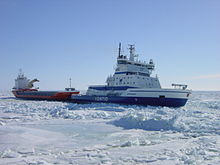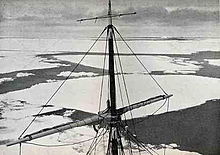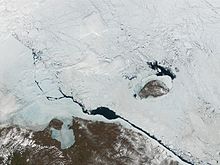- Drift ice
-
 Drift ice, Greenland
Drift ice, Greenland
Drift ice is ice that floats on the surface of the water in cold regions, as opposed to fast ice, which is attached ("fastened") to a shore. Usually drift ice is carried along by winds and sea currents, hence its name, "drift ice".
When the drift ice is driven together into a large single mass, it is called pack ice. Wind and currents can pile up ice to form ridges three to four metres high, creating obstacles difficult for powerful icebreakers to penetrate. Typically areas of pack ice are identified by high percentage of surface coverage by ice: e.g., 80-100%.
An ice floe is a large piece of drift ice that might range from tens of metres (yards) to several kilometres in diameter. Wider chunks of ice are called ice fields.
The two major ice packs are the Arctic ice pack and the Antarctic ice pack.
In many areas such as the Baltic, drift ice is traditionally a seasonal event, appearing in winter and vanishing in warmer seasons.
Seasonal ice drift in the Sea of Okhotsk by the northern coast of Hokkaidō, Japan has become a tourist attraction of this area with harsh climate,[1] and is one of the 100 Soundscapes of Japan. The Sea of Okhotsk is the southernmost area in the Northern hemisphere where drift ice may be observed.[2]
Drift ice affects:
- Security of navigation
- Climatic impact (see Polar ice packs)
- Geological impact
- Biosphere influence (see Ecology of sea ice)
The most important areas of pack ice are the polar ice packs formed from seawater in the Earth's polar regions: the Arctic ice pack of the Arctic Ocean and the Antarctic ice pack of the Southern Ocean. Polar packs significantly change their size during seasonal changes of the year. Because of vast amounts of water added to or removed from the oceans and atmosphere, the behavior of polar ice packs has a significant impact on global changes in climate.
 Icebreaker Kontio assisting merchant vessel in pack ice in the northern Baltic sea. In this photo the Kontio has become stuck in drift ice while towing a cargo ship.
Icebreaker Kontio assisting merchant vessel in pack ice in the northern Baltic sea. In this photo the Kontio has become stuck in drift ice while towing a cargo ship.
See also
- Iceberg
- Ice drift
- Polar ice packs
- Polynya
- Sea ice
- Shelf ice
- Soviet and Russian manned drifting ice stations
References
- ^ "A Port's Ice Is Thinning, and So Is Its Tourist Trade", New York Times, March 14, 2006.
- ^ Honda, Meiji, Koji Yamazaki, Hisashi Nakamura, Kensuke Takeuchi, 1999: Dynamic and Thermodynamic Characteristics of Atmospheric Response to Anomalous Sea-Ice Extent in the Sea of Okhotsk. J. Climate, 12, 3347–3358.
External links
- "Drift Ice as a Geologic Agent", video by US Geologic Survey
- "Ice in the Sea" : chapter from Nathaniel Bowditch's American Practical Navigator
- Cryosphere Today : Current Arctic sea ice conditions
- Data source for sea ice picture
- Marine Modeling and Analysis Branch
- Everything you ever wanted to know about sea ice but were afraid to ask
- Animation of the movement of sea ice, September 2003 through May 2004
- NSIDC Sea Ice Index
- Atlas of Antarctic Sea Ice Drift
Biomes and Ecozones Terrestrial
biomesPolar/montaneTemperate(Sub)tropicalDryWetAquatic
biomesOther biomes Ecozones Categories:- Earth phenomena
- Sea ice
- Glaciology
Wikimedia Foundation. 2010.


